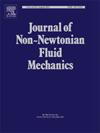Numerical simulation of Poiseuille flow for S-shaped rheology fluid: Streamwise banding and viscous sandglasses
IF 2.7
2区 工程技术
Q2 MECHANICS
引用次数: 0
Abstract
Recent experiments on pressure-driven Poiseuille flow of cornstarch in a cylindrical tube (Talon and Salin, 2024) show a surprising behavior. The measured flow curve, i.e. the flow rate versus the applied pressure drop, is indeed non-monotonic: the flow rate increases monotonically at low pressure drops up to a maximum, after which it decreases abruptly to an almost constant flow rate regardless of further increases in pressure drop. Cornstarch is known to exhibit discontinuous shear thickening (DST) behavior (Fall et al., 2012). In addition, recent experiments (Denn et al., 2018; Darbois Texier et al., 2020; Bougouin et al., 2024) suggest that the rheology may ultimately be S-shaped, where the shear rate is a nonmonotonic function of stress, similar to the model proposed by Wyart and Cates (Wyart and Cates, 2014). To account for the observed jump-plateau behavior of the flow rate, one possibility is that Poiseuille flow for S-shaped rheology exhibits some kind of phase segregation, where the pressure gradient becomes non-uniform. The pressure gradient segregate between two types of region, with either high pressure gradient or low one. This kind of “streamwise banding” were analyzed in Talon and Salin (2024) using the lubrication approximation and assuming simple dynamical stochastic version of the nonmonotonic S-shaped rheology Wyart–Cates model. The plateau behavior is then related to an increase of the high viscous region as the pressure is increased. The mere presence of a non-monotonic rheological curve could then be sufficient to predict the occurrence of banding in the streamwise direction, even if the suspension remains homogeneous.
In this paper, we aim to analyze this prediction by disregarding the lubrication approximation and directly solving the flow of a shear thickening fluid with S-shaped rheology. Using 2D TRT Lattice Boltzmann simulations, we observe that the plateau in flow rate is indeed associated with a streamwise segregation of the pressure gradient. In addition, we show that regions of high pressure gradients are due to the formation of a highly viscous structure similar to a “sandglass” shape. We then analyze the occurrence of these sandglass structures as a function of the system parameters.
求助全文
约1分钟内获得全文
求助全文
来源期刊
CiteScore
5.00
自引率
19.40%
发文量
109
审稿时长
61 days
期刊介绍:
The Journal of Non-Newtonian Fluid Mechanics publishes research on flowing soft matter systems. Submissions in all areas of flowing complex fluids are welcomed, including polymer melts and solutions, suspensions, colloids, surfactant solutions, biological fluids, gels, liquid crystals and granular materials. Flow problems relevant to microfluidics, lab-on-a-chip, nanofluidics, biological flows, geophysical flows, industrial processes and other applications are of interest.
Subjects considered suitable for the journal include the following (not necessarily in order of importance):
Theoretical, computational and experimental studies of naturally or technologically relevant flow problems where the non-Newtonian nature of the fluid is important in determining the character of the flow. We seek in particular studies that lend mechanistic insight into flow behavior in complex fluids or highlight flow phenomena unique to complex fluids. Examples include
Instabilities, unsteady and turbulent or chaotic flow characteristics in non-Newtonian fluids,
Multiphase flows involving complex fluids,
Problems involving transport phenomena such as heat and mass transfer and mixing, to the extent that the non-Newtonian flow behavior is central to the transport phenomena,
Novel flow situations that suggest the need for further theoretical study,
Practical situations of flow that are in need of systematic theoretical and experimental research. Such issues and developments commonly arise, for example, in the polymer processing, petroleum, pharmaceutical, biomedical and consumer product industries.

 求助内容:
求助内容: 应助结果提醒方式:
应助结果提醒方式:


